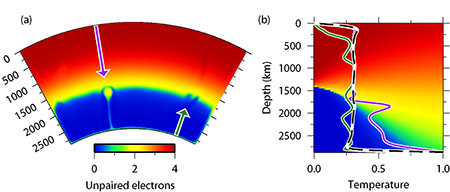Enhanced convection and fast plumes in the lower mantle induced by the spin transition in ferroperic
Posted: Tue, 2009-09-15 12:46

Using a numerical model we include the intrinsic density change that occurs from high to low-spin ferropericlase around 50 GPa [ Sturhahn et. al., 2005 ]. This generates buoyancy similar to a discrete phase change. However, in pressure-temperature space the spin transition occurs over an extended pressure range for warmer material (Figure 1). The temperature broadening effect distributes spin- buoyancy over a large pressure range for warm plumes a nd a tight pressure range for cold slabs. In the deep mantle, spin-buoyancy works with therma l buoyancy and convection is enhanced for both upwellings and downwellings. In the shallow lowe r mantle spin-buoyancy m ildly hinders convection.
Although the additional buoyancy does not fundamentally alter the large-scale dynamics, the Nusselt number increases by 5-10%, and vertical velocities by 20-45% in the lower mantle. Advective heat transport is more effective and temperatures in the core-mantle boundary region are reduced by up to 10%.
The spin transition, in addition to the Pv-pPv phase change, is a destabilizing mechanism that will further work against the stability of lowermost mantle structures. Furthermore, it provides additional buoyancy to small-scale hot plumes, such as those that possibly emanate from the edges of large low velocity structures.
Download summary
Download article
